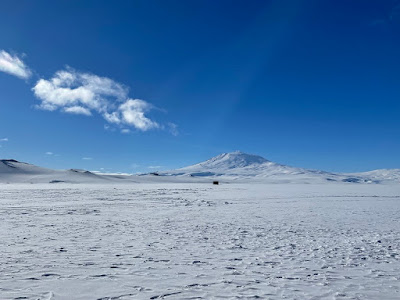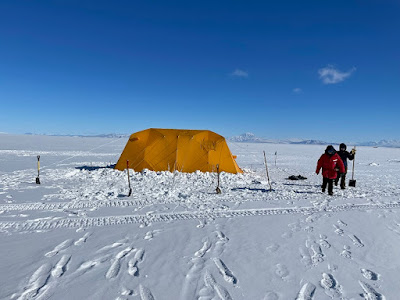I camped on the Ross Ice Shelf on Tuesday night to test out my sleep kit before heading out to the field.
 |
Deep Field Shakedown
Every science group going into the deep field goes through a deep field shakedown. We camp out on the Ross Ice Shelf, about a 30 min snowmobile ride away from McMurdo. This is done to practice setting up tents and test out our sleep kits to make sure we'll be warm enough in the field.
The first step was for the TIME team to gather all of our gear in McMurdo and drive it out to the transition. The transition is where the dirt road from McMurdo turns into the snowy/icy road on the Ross Ice Shelf. There are certain limits about which vehicles can drive out on the snow roads because any dirt/gravel can melt the snow road and make it unsafe to travel. Last season, the transition got very mushy and a truck got stuck, and then the mush froze over and the truck had to be towed out.
So we loaded up a truck to drive our gear down to the transition, where we then loaded it all up on snowmobiles to haul it out to the camping site. There's only one truck that we can borrow (all the other trucks are being used for construction projects going on around town this season), so this involved a lot of waiting.
 |
| TIME team waiting with our sleep kits and personal gear to be picked up by the truck. Someone took the opportunity to nap. |
We also took our camp stove and some dehydrated meals for dinner, since we'd be out camping all of Tuesday and Wednesday.
 |
The camping spot on the Ross Ice Shelf had a stunning view of Erebus, and the weather was absolutely beautiful: clear and still.
 |
| View of Erebus from the Deep Field Shakedown camping area. |
The first step was to practice setting up the Arctic Oven tent. We will have 3 Arctic Ovens in the deep field, with one as a science tent and two as kitchen tents for our large 14-person team. The tent took a while for us to set up, and featured a vestibule, a flap on the rain fly that we buried in snow, plus 22 guy lines. We made deadman anchors in the snow, digging thin trenches to put a piece of bamboo in horizontally, then wrap the guy line around and tie it off with a trucker's hitch. I am now an expert in the trucker's hitch.
 |
 |
Then we set up Scott tents to sleep in. The Scott tents we used are large yellow pyramids, based on a design used by Robert Falcon Scott, an early Antarctic explorer. Scott tents are extremely stable, even in high winds, and only two storms have ever blown away Scott tents in the history of the US Antarctic Program. Once again, setting these up required a lot of digging for deadman anchors and to cover the vestibule with snow.
 |
The
tents are double-layered, and there's a ~2ft diameter, round tube of fabric that sticks out from the front wall. This is the door. To climb inside, you elegantly crawl on your hands and knees in the snow and yank your giant boots inside (well, maybe not so elegantly). Kind of like a kids' play tunnel.
Inside the tent, the apex is about 7ft tall, so they're quite roomy with plenty of space to stand up. In the field, we'll each share a tent with one person -- my tentmate was Meghana, a postdoc who models glaciers and ice sheets!
 |
 |
We had dinner and talked about the different kinds of risks we'd run into in the field. Then unloaded our sleep kits from the snowmachines and went to sleep! I was surprisingly warm in a double-layered sleeping bag, fleece bag liner, long johns, fleece pants/shirt, socks, and my beautiful electric blue down booties. Getting out of the sleeping bags in the morning was a different matter. It was definitely still below freezing in the tent.
 |
Wednesday morning, we spent several hours un-doing all of our hard work and took down the tents. Then we snowmobiled over to the artificial crevasse for crevasse rescue training!
Field Season Updates
The field season plan is ever changing (I heard one piece of information at 9am yesterday, and a completely different plan at 11am...). But the most recent news I heard is that we are supposed to go into a 5-day isolation on 07 Dec and fly out to WAIS field camp the week of 12 Dec.
The WAIS field camp put-in crew (aka the people that set up camp and open it for science groups) are currently waiting on a good weather window to fly in. The weather at WAIS is notoriously bad, and there's no weather report (because no people are out there) so it's often difficult to tell what the weather even is out there. Here's hoping that WAIS camp gets set up soon!
- Get link
- X
- Other Apps
Labels
Antarctica 22/23- Get link
- X
- Other Apps
Popular posts from this blog
- Get link
- X
- Other Apps
- Get link
- X
- Other Apps
- Get link
- X
- Other Apps
Comments
Love. Mom
I love you, Hunta!!